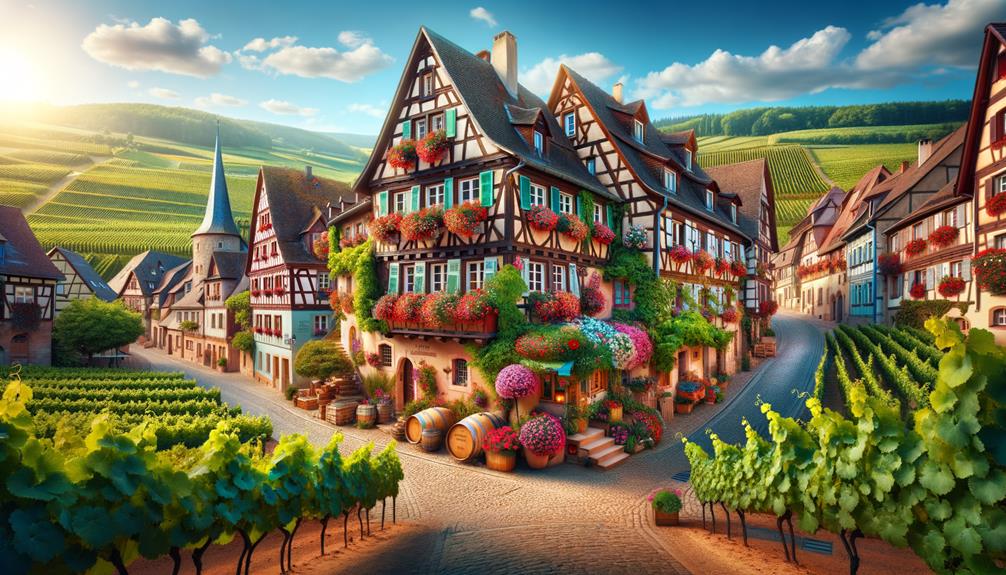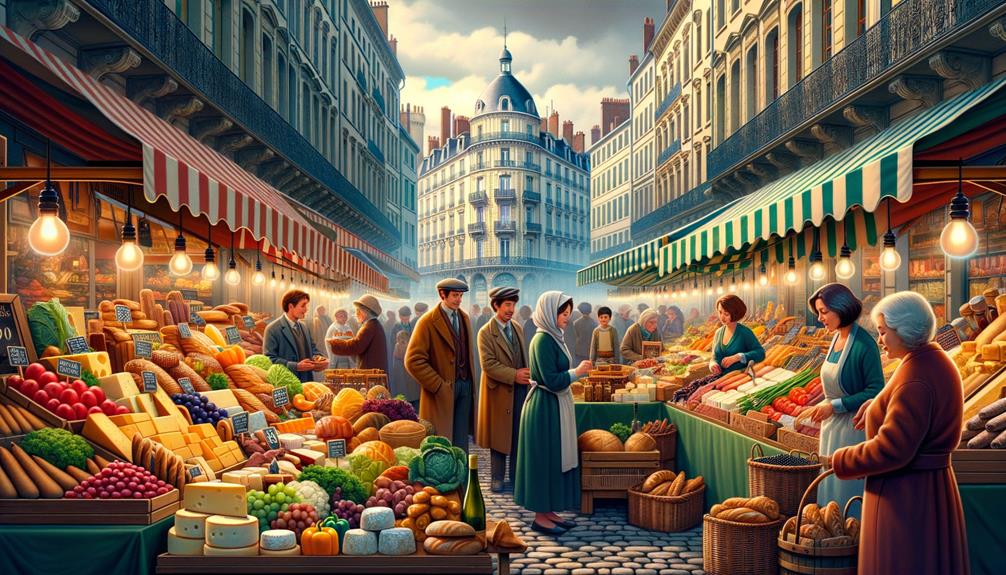Wandering through Colmar, the heart of the Alsace Wine Route, felt like stepping into a fairy tale. The vibrant half-timbered houses, cobblestone streets, and colorful facades seemed to whisper stories from centuries ago. Each village, from Eguisheim to Riquewihr, had its own unique charm, surrounded by scenic vineyards offering the delightful flavors of Riesling and Gewürztraminer. This journey was more than just beautiful scenery; it was a sensory dive into history and wine culture. But the most fascinating part of my adventure was still to come, waiting to reveal its secrets.
Exploring Colmar's Charm
As I wander through Colmar's narrow streets, I'm struck by the vibrant half-timbered houses and cobblestone pathways that seem to whisper stories from centuries ago. Every turn reveals a picturesque scene, with colorful facades standing out against the sky like a painter's palette. The intricate woodwork and flower-filled windowsills add a timeless elegance that makes me pause and reflect.
Walking along, it feels like I've stepped into a storybook village where history breathes through every brick and beam. The unique patterns and hues of the half-timbered houses give a glimpse into the architectural traditions that have shaped this region. Each building seems to share secrets of bygone eras, making the experience deeply immersive.
The winding, uneven cobblestone lanes guide me through a maze of quaint shops, inviting cafés, and hidden courtyards. It's a place where exploring feels liberating, and every small discovery adds to the richness of the journey. The beautiful landscape around Colmar, with its plains, mountains, and vineyards, only adds to the sense of peace and wonder. In Colmar, charm isn't just visible—it's felt with every step.
Highlights of the Alsace Wine Route
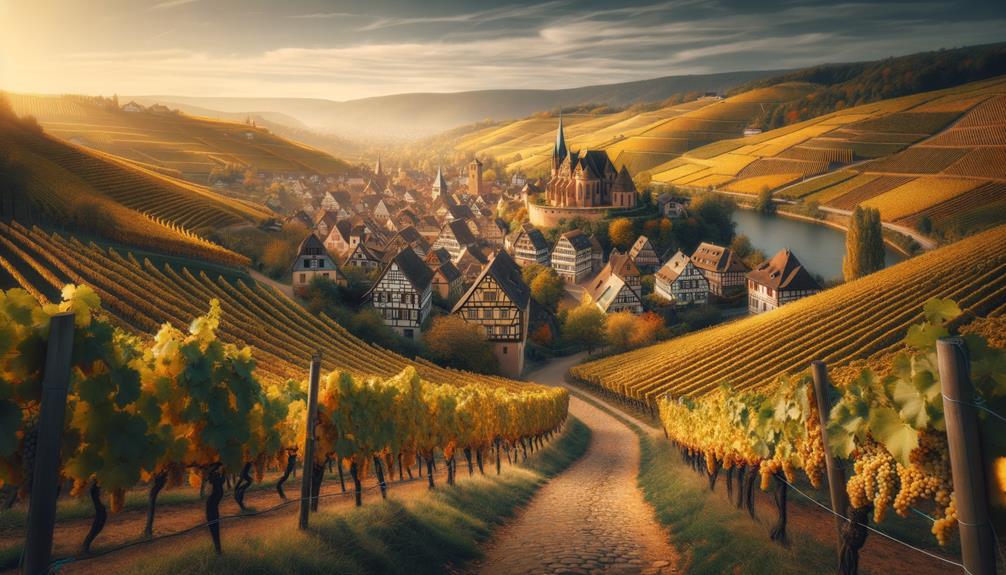
The Alsace Wine Route is a delightful journey through scenic vineyards and charming villages like Eguisheim, Kaysersberg, and Riquewihr. Each village feels like a fairy tale, with half-timbered houses and cobblestone streets inviting you to explore. Wandering through these picturesque settings, the mix of tradition and elegance is truly captivating.
Eguisheim's winding streets, Kaysersberg's historic feel, and Riquewihr's enchanting views offer a refreshing escape from the everyday. The vineyards stretch out in a beautiful patchwork of green, nestled against the backdrop of plains and mountains. It's a visual delight, and every step along the Alsace Wine Route feels like walking through a living postcard.
Colmar, the heart of this region, is more than just the Alsatian wine capital; it's a cultural gem. The town's rich heritage and vibrant atmosphere make it a must-visit for any wine lover. Immersing myself in the local culture, I appreciate the seamless blend of natural beauty and historical richness that defines the Alsace Wine Route.
Alsace Vineyard Marathon
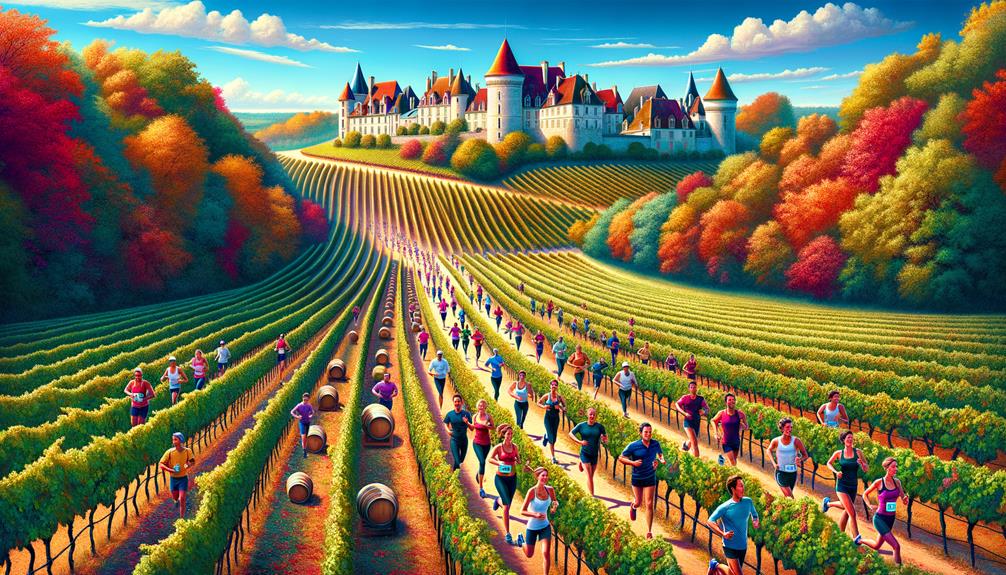
Running the Alsace Vineyard Marathon is like joining a lively festival of sport, culture, and stunning views. As I tie my shoes, I'm gearing up not just for a marathon but for an adventure through Alsace's scenic hills, quaint villages, and beautiful vineyards. The energy is infectious, with runners in creative costumes adding to the excitement.
Along the route, I'm charmed by the 12 relay stations offering a taste of local Alsatian dishes. Each stop is a mini celebration, letting me enjoy the region's food while recharging for the next part of the race.
Here are four reasons why the Alsace Vineyard Marathon stands out:
- Beautiful Scenery: The course goes through breathtaking landscapes that are truly eye-catching.
- Tasty Local Food: Runners get to sample local delicacies, making every mile a flavorful journey.
- Festive Spirit: The unique costumes and lively atmosphere make the race a joyous occasion.
- Cultural Experience: The marathon provides a genuine taste of Alsatian culture and friendliness.
Running this marathon isn't just a physical challenge; it's a celebration of the good things in life.
Northern Alsace Wine Route
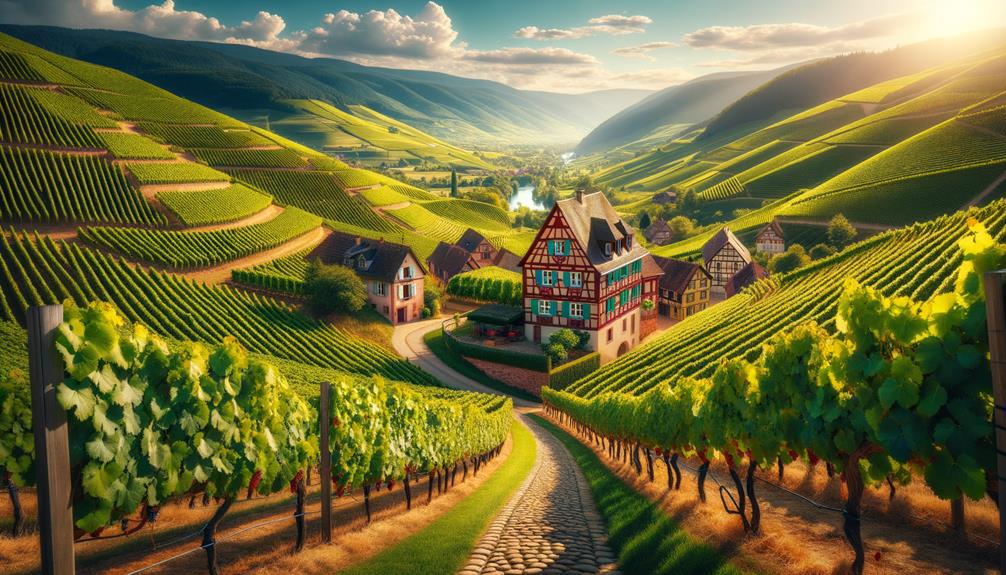
Strolling along the Northern Alsace Wine Route felt like stepping into history. The vineyards, some dating back to the 8th century, showcased their rich heritage in every sip. The variety of Alsatian grapes, from Riesling to Pinot Noir, offered a range of flavors that were both intriguing and comforting. Villages like Wissembourg and Hunspach added cultural richness, making each stop unforgettable.
Historic Vineyards and Heritage
Traveling along the Northern Alsace Wine Route, I find myself entranced by vineyards that have roots stretching back to the 8th century. Each plot whispers tales of time-honored traditions and the dedication of countless generations. The region's historic charm is unmistakable, especially in the picturesque villages of Wissembourg, Hunspach, and Cleebourg. With their timber-framed houses and winding cobblestone streets, these villages beckon me to delve deeper into their rich winemaking history.
The lush landscapes of Northern Alsace are a testament to the enduring legacy of local viticulturists. As I wander through these ancient vineyards, I can almost sense the hands of those who came before, carefully tending to their vines. Seeing the orderly rows of grapevines stretching out to the horizon is truly captivating.
Here are four must-see highlights of this route:
- Wissembourg: Stroll through the medieval streets and visit its historic churches.
- Hunspach: Take in the beauty of one of France's most charming villages with its traditional Alsatian homes.
- Cleebourg: Stop by the Cleebourg Wine Cellar for a taste of local wines.
- Strasbourg Vineyards: Follow the scenic path and explore prestigious wine estates.
This journey through Northern Alsace invites you to appreciate the past and celebrate the timeless craft of winemaking.
Alsatian Grape Varieties
Wandering through the Northern Alsace Wine Route, I'm continually amazed by the variety of grapes grown in this storied region. These vineyards have thrived since the 8th century, showcasing the deep-rooted dedication of local vintners.
Among the top Alsatian grape varieties, Sylvaner, Riesling, and Gewurztraminer stand out, each bringing something special to the table. Riesling here is crisp and refined, while Gewurztraminer offers spicy, aromatic notes. Sylvaner, often underrated, delivers a refreshing and subtly fruity taste.
Visiting spots like Wissembourg, Hunspach, and Cleebourg, I get a real sense of the unique soils and climates that shape this area. Being close to the German border adds a distinct charm, and the vineyards, just 60 km north of Strasbourg, blend tradition with modern techniques.
The diversity doesn't stop there; Pinot Noir, Muscat, and Pinot Gris also flourish here. Each vineyard visit reveals new layers of complexity and skill, making the Northern Alsace Wine Route a rich mosaic of flavors and stories. It's a journey filled with delightful surprises.
Village Highlights
Strolling through the villages along the Northern Alsace Wine Route is like stepping into a living history book. From the charming streets of Wissembourg to the peaceful vineyards of Cleebourg, each village tells its own unique story. The blend of French and German influences is evident everywhere, reflecting the region's rich heritage.
- Wissembourg: With its half-timbered houses and medieval architecture, this village feels like a journey back in time. The Abbey Church of St. Peter and St. Paul stands out as a significant historical landmark.
- Hunspach: Known for its traditional whitewashed houses with wooden balconies, Hunspach looks like it's straight out of a fairy tale. The warm hospitality of the locals and the village's tranquil atmosphere make it an ideal place to relax and reflect.
- Cleebourg: Surrounded by vineyards dating back to the 8th century, Cleebourg offers a close connection to nature. The dedication of local winemakers is evident in every sip of their Riesling or Gewurztraminer.
- Seebach: This village is a lively mix of cultural heritage and beautiful landscapes. The annual 'Streisselhochzeit' festival, celebrating traditional Alsatian weddings, adds a vibrant touch to its already picturesque setting.
As I explore these villages, I'm continually reminded of the timeless beauty and traditions that make the Northern Alsace Wine Route so special.
Strasbourg Vineyards
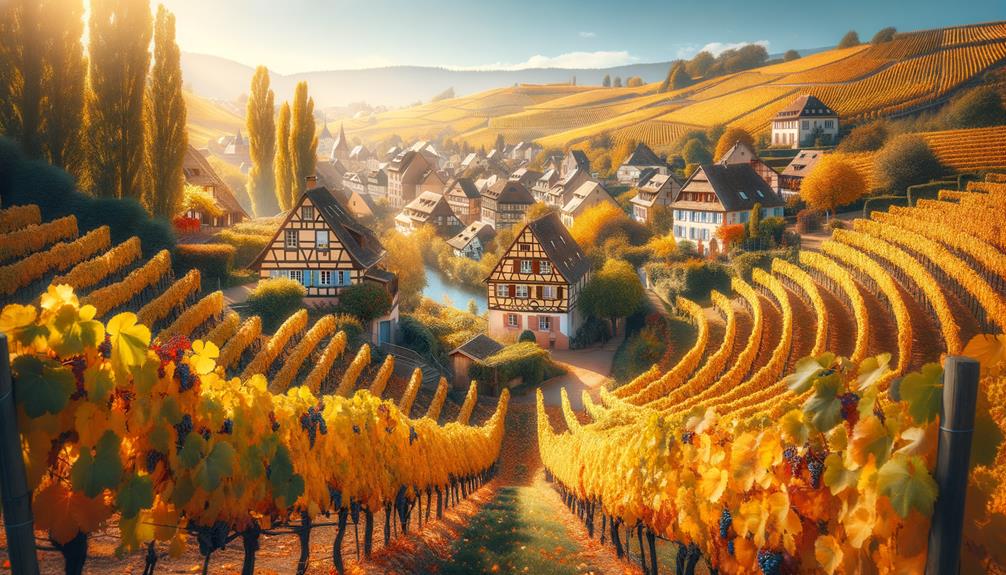
The Strasbourg Vineyards, which stretch from Marlenheim to Molsheim, take you on a delightful journey through Alsace's charming medieval villages and lush landscapes. As I wandered along this northern gateway to the Alsace Wine Route, I couldn't help but be captivated by the mix of history, culture, and nature. The landscape, with its vineyards and forests, offered stunning views at every turn.
The tranquility of the area was soothing. Prestigious wine estates showcased the land's bounty and the exceptional quality of Alsatian wines. Each village, with its cobblestone streets and half-timbered houses, seemed to tell stories of bygone eras, standing as silent witnesses to centuries of tradition.
Wine tasting here is a sublime experience. Sipping a glass of Gewurztraminer in a cozy wine cellar, I felt a deep connection to the rich heritage and meticulous craftsmanship that define this region.
Here's a glimpse of what makes the Strasbourg Vineyards special:
| Feature | Description |
|---|---|
| Route Stretch | Marlenheim to Molsheim |
| Landscape | Verdant vineyards and forests |
| Historical Charm | Medieval Alsatian villages |
| Wine Estates | Prestigious and renowned |
| Wine Variety | Rich selection of Alsatian wines |
As I wandered through the Strasbourg Vineyards, I savored each moment, relishing the freedom and beauty of this captivating part of Alsace.
Centre Alsace Vineyards
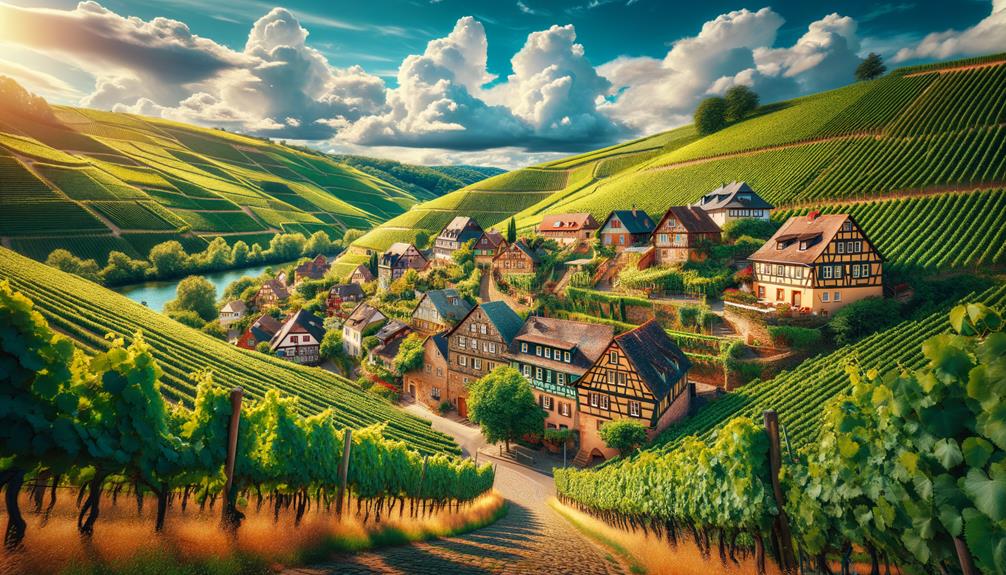
Situated between Strasbourg and Colmar, the Centre Alsace Vineyards are a delightful mix of vineyards, forests, and quaint villages. As I stroll through this scenic area, I'm amazed by how nature and history come together. The ruins of Haut-Koenigsbourg castle stand tall, offering a glimpse into the past.
As I walk through these villages, the cobblestone streets and half-timbered houses feel like they're sharing stories from long ago. The scent of grapevines is everywhere, hinting at the region's renowned wines like Klevener de Heiligenstein and Rouge d'Ottrott.
Here are some highlights of Centre Alsace Vineyards:
- Historical Richness: Visit the ruins of Haut-Koenigsbourg and the Romanesque Road that runs through the Wine Route.
- Breathtaking Scenery: Take in the views of rolling vineyards and lush forests.
- Culinary Treats: Enjoy the distinctive tastes of Klevener de Heiligenstein and Rouge d'Ottrott wines.
- Charming Villages: Wander through villages like Eguisheim, Kaysersberg, and Riquewihr, each with its own unique appeal.
In Centre Alsace, every sip, step, and story offers a sense of freedom and discovery.
Colmar Vineyards

As I strolled through Colmar Vineyards, I couldn't help but admire the beautiful mix of plains, mountains, and vineyards that created such a stunning view. The historic villages like Eguisheim and Kaysersberg, with their half-timbered houses and cobblestone streets, seemed to tell stories from the past. Every step felt like walking through a living postcard, capturing the heart of Alsace's wine culture.
Picturesque Village Landscapes
The moment I arrived at the Colmar Vineyards, I was struck by the breathtaking mix of plains, mountains, and beautifully arranged vineyards. It was a scene of timeless beauty. Exploring the picturesque villages in the area, each with its own unique charm and cultural heritage, felt like a journey back in time.
Eguisheim, Kaysersberg, and Riquewihr particularly caught my eye with their half-timbered houses and cobblestone lanes, truly capturing the essence of Alsatian tradition. Walking through these villages, I felt a sense of freedom and wonder as I soaked in the enchanting views.
Here are some highlights from my trip through these village landscapes:
- Eguisheim: Surrounded by vineyards, this village is famous for its winding streets and colorful facades, creating a fairy-tale atmosphere.
- Kaysersberg: Known for its medieval architecture and scenic river, Kaysersberg felt like stepping back in time, offering a peaceful escape.
- Riquewihr: Often described as one of the prettiest villages in France, Riquewihr's historical charm and vibrant flowers left a lasting impression.
- Colmar: As the wine capital of Alsace, Colmar offers a mix of cultural richness and natural beauty, making it an ideal starting point for exploring the region.
In these picturesque villages, every corner had a story to tell, and every view was a masterpiece.
Rich Wine Heritage
Strolling through the Colmar Vineyards, I was struck by the long-standing traditions and careful craftsmanship that define this area's wine heritage. The landscape here is a beautiful mix of plains, rolling hills, and vast vineyards. Every step I took brought me closer to understanding why Colmar is known as the wine capital of Alsace.
The charming villages of Eguisheim, Kaysersberg, and Riquewihr, with their timbered houses and cobblestone streets, felt like scenes from a storybook. History is tangible here, woven into the very essence of these picturesque settings. The vineyards, stretching to the mountains, offer more than just a pretty view; they tell tales of generations committed to winemaking.
As I wandered around, I realized this area offers more than just great wines. It's a cultural mosaic, blending history, natural beauty, and a lively, unique lifestyle. Each village, with its own special charm, invites travelers to stop and enjoy the moment. The Colmar Vineyards offer not just a taste of fine wines, but an unforgettable experience filled with elegance and authenticity.
Southern Alsace Wine Route
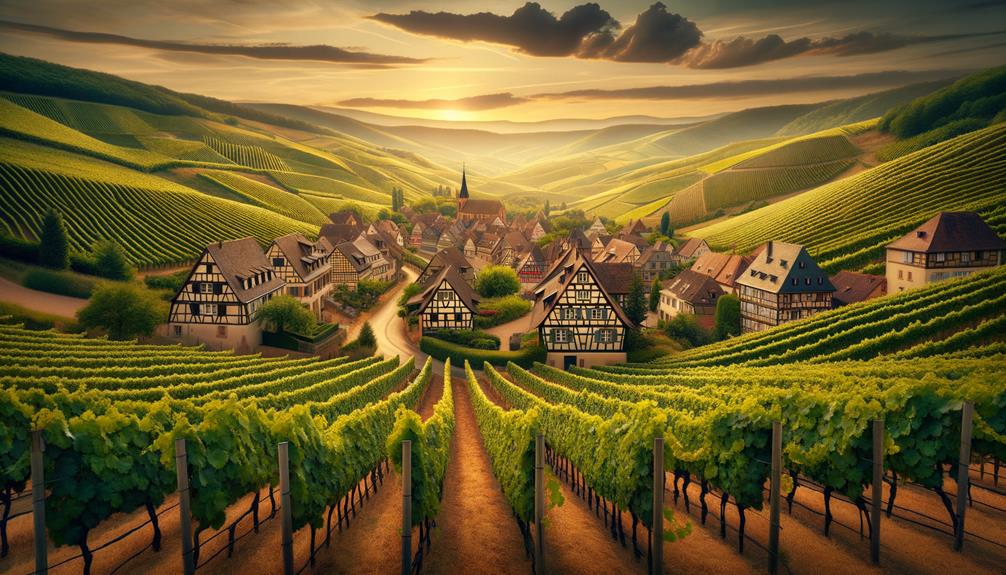
The Southern Alsace Wine Route, which runs between Thann and Soultzmatt, offers a captivating journey through steep vineyard slopes and stunning landscapes. As I travel along this route, I'm constantly struck by the unique aromas and flavors of its Grands Crus. The vineyards, descending from the Vosges to the Alsatian plain, have a character all their own.
In places like Thann, home to the famous Rangen Grand Cru, and Guebwiller, known for its exceptional Grands Crus, I find myself fully immersed in a world where nature and winemaking come together seamlessly. The views are unmatched, with a beautiful mix of plains, mountains, and vineyards stretching far and wide.
Here are four highlights of this spectacular route:
- Rangen Grand Cru in Thann: Known for its volcanic soil, which gives the wines a distinct mineral taste.
- Guebwiller's Grands Crus: A historic town with a wide variety of top-tier wines.
- Steep Vineyard Slopes: Challenging terrains that produce unique wine profiles.
- Panoramic Landscapes: Stunning views that make the journey as enjoyable as the destination.
In this region, the joy of experiencing nature and wine in their purest forms is truly freeing.
Planning Your Alsace Trip
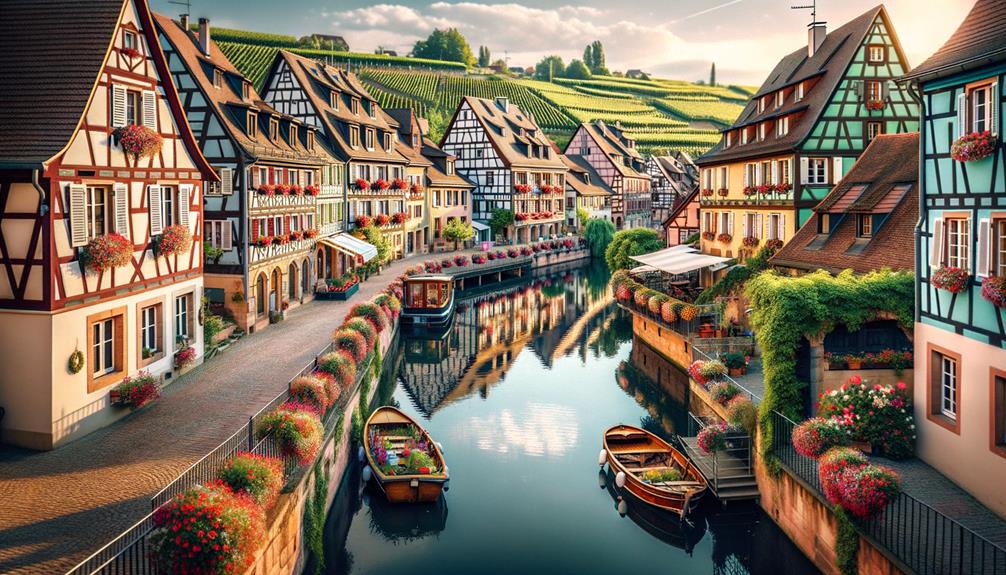
I'm savoring the last sips of wine from the Southern Alsace Wine Route and can't wait to share some tips on planning your own memorable trip through this charming region. Running 170 kilometers long, the Alsace Wine Route winds through beautiful landscapes filled with vineyards, forests, and old ruins. It's perfect for travelers looking for both beauty and adventure.
Start by noting the key stops along the route. Be sure to visit friendly winstubs, bustling cellars, and historic homes. Romanesque churches and Renaissance fountains are scattered throughout the region and are worth a visit. Each stop offers a unique look into Alsatian life and its culinary delights.
For a deeper experience, take some time to find hidden paths and meet the passionate winemakers who make this region special. Wander the medieval streets of quaint towns and enjoy stunning views that feel almost magical.
For more information on Alsatian wines, vineyards, and festivals, check out www.vinsalsace.com. It's a great resource for exploring the rich history and environment that make the Alsace Wine Route a unique journey. So, pack your bags and let yourself be enchanted by the Route des Vins!
Frequently Asked Questions
How Long Does It Take to Drive the Alsace Wine Route?
Driving the Alsace Wine Route typically takes around 3 to 4 hours, but I'd suggest giving yourself a few days to truly enjoy it. The trip isn't just about covering the distance; it's about experiencing the vineyards, medieval villages, and stunning scenery along the way.
Where Does the Alsace Wine Route Start?
The Alsace Wine Route begins in the charming town of Thann. Wandering through Thann's beautiful architecture, I felt a sense of freedom, ready to visit the delightful villages and exceptional vineyards that lay ahead.
Which Wine Region Is Colmar In?
Colmar is in the Alsace wine region. I love walking through its vineyards, each sip reflecting centuries of tradition. It's a place where you can freely enjoy and appreciate unique, exquisite wines.
What Is the Wine Capital of Alsace?
Colmar, the gem of Alsace, is the heart of its wine country. Strolling through its cobblestone streets, I was captivated by the charm of the half-timbered houses and sprawling vineyards. This place isn't just a spot on the map; it's like stepping into a fairytale.

